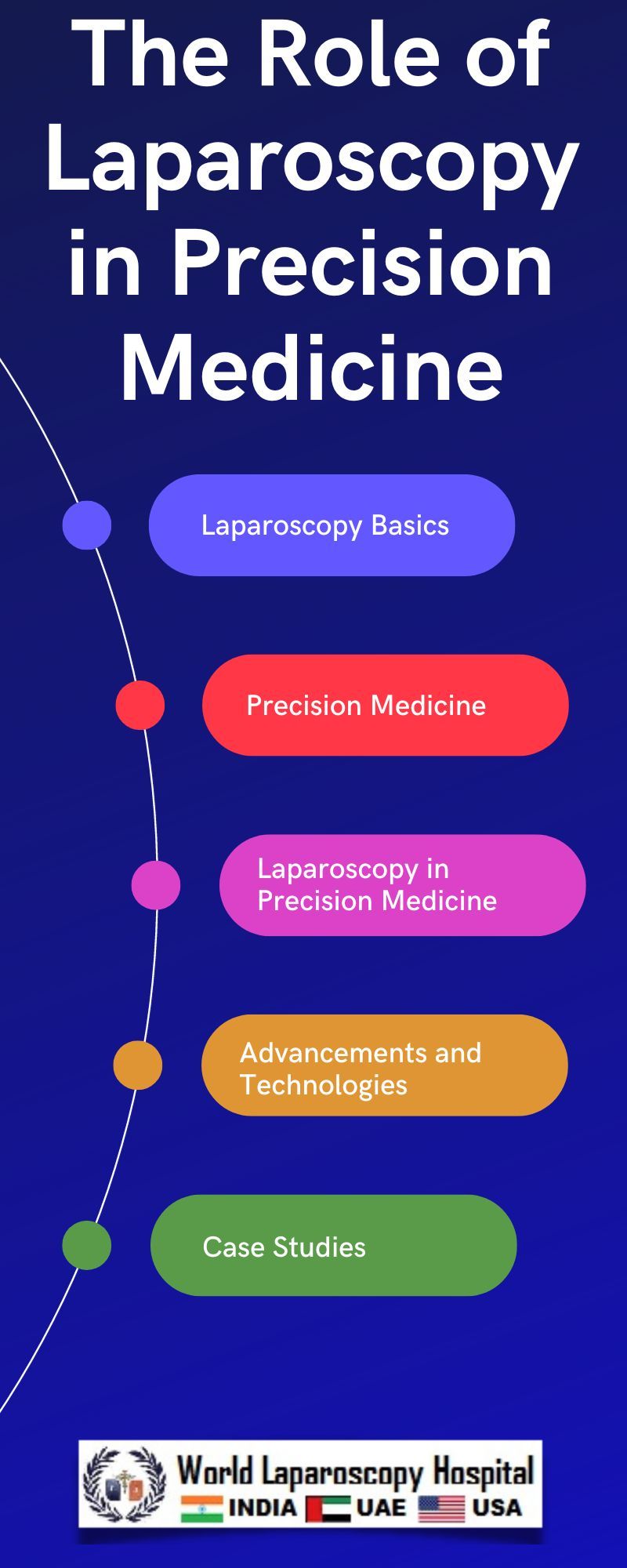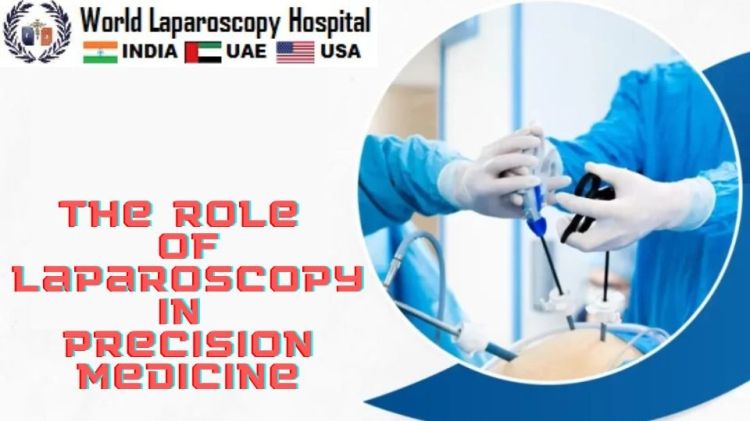The Role of Laparoscopy in Precision Medicine
Introduction
Precision medicine is revolutionizing healthcare by tailoring medical decisions and interventions to the individual characteristics of each patient. In this paradigm shift, advanced surgical techniques play a crucial role in enhancing precision and optimizing outcomes. Laparoscopy, a minimally invasive surgical procedure, emerges as a key player in the realm of precision medicine, offering a spectrum of benefits that contribute to personalized patient care.

Understanding Precision Medicine
Precision medicine, also known as personalized medicine, is a groundbreaking approach that takes into account individual differences in people's genes, environments, and lifestyles. Unlike the traditional one-size-fits-all model, precision medicine aims to customize healthcare to the unique characteristics of each patient. This involves the integration of molecular and genetic information to diagnose, treat, and prevent diseases more effectively.
The Significance of Laparoscopy
Laparoscopy Overview:
Laparoscopy, commonly known as minimally invasive surgery, involves making small incisions through which a camera and specialized surgical instruments are inserted. This technique provides a visual magnification of the surgical field, allowing surgeons to perform intricate procedures with greater precision. Laparoscopy is widely used in various medical specialties, including gynecology, urology, gastroenterology, and general surgery.
Precision Medicine and Laparoscopy Synergy:
Precise Diagnostics:
Laparoscopy facilitates accurate diagnosis through direct visualization of internal organs. High-resolution cameras enable surgeons to detect subtle abnormalities, aiding in the early identification of diseases. This precision in diagnostics aligns with the goals of precision medicine, where an accurate understanding of the patient's condition is fundamental to developing targeted therapies.
Personalized Treatment Planning:
The minimally invasive nature of laparoscopy contributes to reduced trauma and faster recovery, allowing for a more tailored approach to treatment. In precision medicine, individualized treatment plans are designed based on the patient's unique characteristics, and laparoscopy aligns seamlessly with this philosophy by enabling customized interventions that consider the patient's overall health.
Genomic Integration:
Laparoscopic procedures can be integrated with genomic information for a comprehensive approach. For example, in oncological cases, laparoscopy can aid in obtaining tissue samples for genetic testing. This genetic data, combined with the visual insights provided by laparoscopy, empowers clinicians to formulate targeted therapies that address the specific molecular characteristics of a patient's cancer.
Applications of Laparoscopy in Precision Medicine
Laparoscopy Across Medical Specialties:
Gynecology:
Laparoscopy is extensively used in gynecological procedures such as hysterectomy, myomectomy, and ovarian cyst removal. The precision offered by laparoscopy is particularly beneficial in preserving fertility and optimizing outcomes for conditions like endometriosis.
Urology:
In urological surgeries, laparoscopy proves valuable for procedures like nephrectomy, prostatectomy, and cystectomy. The minimally invasive nature reduces postoperative complications, aligning with the principles of precision medicine to prioritize patient-specific factors.
Gastroenterology:
Laparoscopy is employed in various gastrointestinal surgeries, including cholecystectomy and colectomy. The ability to visualize and access the abdominal cavity with minimal invasiveness enhances precision in the treatment of conditions such as inflammatory bowel disease and colorectal cancer.
General Surgery:
Laparoscopic techniques are applied in a range of general surgical procedures, from hernia repair to appendectomy. The personalized approach afforded by laparoscopy contributes to better patient outcomes and aligns with the broader goals of precision medicine.
Challenges and Opportunities
Challenges:
Technological Hurdles:
Despite its advantages, laparoscopy requires sophisticated equipment and training. Access to advanced laparoscopic tools may be limited in certain healthcare settings, posing challenges to widespread adoption.
Learning Curve:
Surgeons transitioning from traditional open surgery to laparoscopy face a learning curve. Proficiency in laparoscopic techniques demands training and experience, and not all surgeons may have equal access to such opportunities.
Opportunities:
Technological Advancements:
Ongoing advancements in laparoscopic technology, including robotic-assisted surgery, hold promise for overcoming existing challenges. These innovations can enhance the accessibility and ease of laparoscopic procedures, promoting their integration into precision medicine practices.
Training Initiatives:
Investments in training programs can address the learning curve associated with laparoscopy. Comprehensive educational initiatives can ensure that surgeons across various specialties are proficient in utilizing minimally invasive techniques, fostering a broader application of laparoscopy in precision medicine.
Future Directions
Innovation in Surgical Techniques:
Robotic-Assisted Surgery:
The evolution of robotic-assisted surgery represents a promising frontier in laparoscopy. Robotics offer enhanced precision, dexterity, and the ability to overcome some of the limitations associated with traditional laparoscopy, potentially expanding the scope of minimally invasive procedures.
Nanotechnology Integration:
The integration of nanotechnology into laparoscopic procedures holds potential for targeted drug delivery and real-time monitoring at the molecular level. This convergence of nanotechnology and laparoscopy can further enhance the precision of interventions and contribute to the goals of precision medicine.
Expanding Access to Laparoscopy:
Global Training Initiatives:
Bridging the gap in laparoscopic proficiency requires global efforts to establish comprehensive training programs. Collaborations between medical institutions, industry partners, and policymakers can facilitate the dissemination of laparoscopic skills, ensuring that surgeons worldwide can leverage this technology for precision medicine.
Telemedicine in Surgical Training:
The integration of telemedicine can democratize access to laparoscopic training. Virtual platforms and simulation technologies enable remote guidance and mentorship, empowering surgeons in resource-limited settings to enhance their laparoscopic skills.
Conclusion
Laparoscopy, as a cornerstone of minimally invasive surgery, plays an integral role in advancing the principles of precision medicine. Its applications across various medical specialties contribute to precise diagnostics, personalized treatment planning, and the integration of genomic information. While challenges exist, ongoing technological innovations and global training initiatives present opportunities to overcome barriers and expand the reach of laparoscopy in precision medicine. As the healthcare landscape continues to evolve, the synergy between laparoscopy and precision medicine holds the promise of revolutionizing patient care on an individualized and molecular level.
